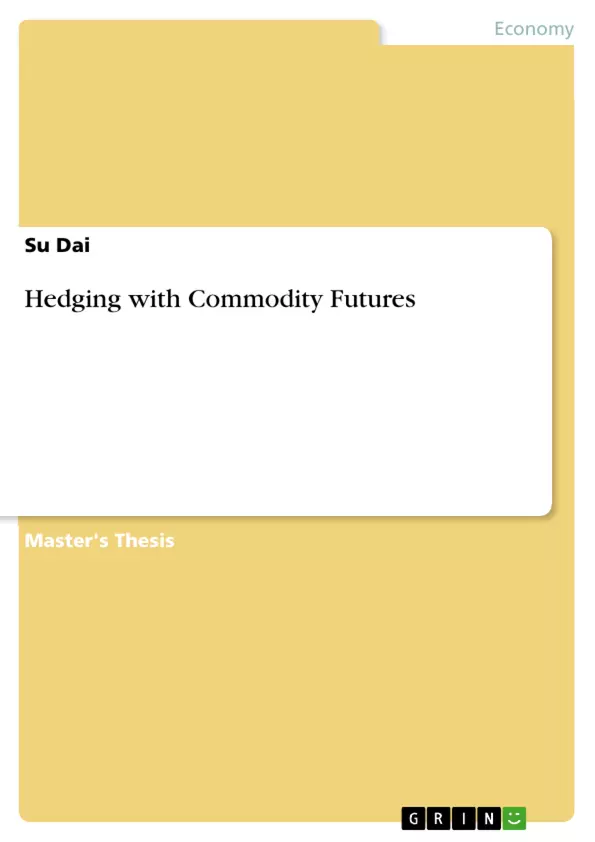The commodity futures contract is an agreement to deliver a specific amount of commodity at a future time . There are usually choices of deliverable grades, delivery locations and delivery dates. Hedging belongs to one of the fundamental functions of futures market. Futures can be used to help producers and buyers protect themselves from price risk arising from many factors. For instance, in crude oil commodities, price risk occurs due to disrupted oil supply as a consequence of political issues, increasing of demand in emerging markets, turnaround in energy policy from the fossil fuel to the solar and efficient energy, etc. By hedging with futures, producers and users can set the prices they will receive or pay within a fixed range. A hedger takes a short position if he/she sells futures contracts while owning the underlying commodity to be delivered; a long position if he/she purchases futures contracts.
The commonly known basis is defined as the difference between the futures and spot prices, which is mostly time-varying and mean-reverting. Due to such basis risk, a naïve hedging (equal and opposite) is unlikely to be effective. With the popularity of commodity futures, how to determine and implement the optimal hedging strategy has become an important issue in the field of risk management.
Hedging strategies have been intensively studied since the 1960s. One of the most popular approaches to hedging is to quantify risk as variance, known as minimum-variance (MV) hedging. This hedging strategy is based on Markowitz portfolio theory, resting on the result that “a weighted portfolio of two assets will have a variance lower than the weighted average variance of the two individual assets, as long as the two assets are not perfectly and positively correlated.”
MV strategy is quite well accepted, however, it ignores the expected return of the hedged portfolio and the risk preference of investors. Other hedging models with different objective functions have been studied intensively in hedging literature. Due to the conceptual simplicity, the value at risk (VaR) and conditional value at risk (C)VaR have been adopted as the hedging risk objective function.
[...]
Table of Contents
- Introduction
- Hedging Strategies
- Risk Measures
- Standard Deviation and Its Variance
- VaR and CVaR
- Optimization of Hedging Objective Functions
- Minimum Variance Hedge
- Minimum (C)VaR Hedge
- Modeling Conditional Return Distribution
- Relationship between Futures and Spot Prices
- GARCH Models
- GARCH (1,1)
- Elliptical Distribution
- Multivariate GARCH
- Regime Switching Models
- Markov Chains
- Mixture of Distributions
- MRS-Model
- MRS-GARCH Model
- Implementation
- Description of the Data and Their Properties
- Testing for Normality
- Testing for ARCH Effects
- Testing for Stationarity
- Testing for Cointegration
- Parameter Estimation
- Estimation Results
- Hedge Ratios
- Hedging Effectiveness of the Hedging Strategy
- Conclusion and Future Outlook
Objectives and Key Themes
This master thesis aims to explore and evaluate different hedging strategies for managing the risk associated with commodity futures. The focus is on developing and comparing various dynamic hedging approaches based on different models for conditional return distributions. * **Risk Management with Commodity Futures:** The thesis examines the use of commodity futures for mitigating price risk in the context of portfolio management. * **Dynamic Hedging Strategies:** The work investigates and compares dynamic hedging strategies that adjust hedge ratios based on evolving market conditions. * **Modeling Conditional Return Distribution:** The study explores different models, including GARCH and regime-switching models, to capture the dynamics of commodity price movements. * **Hedging Effectiveness Evaluation:** The thesis evaluates the effectiveness of the proposed hedging strategies by comparing their performance against traditional static approaches. * **Empirical Analysis:** The study employs real-world data to illustrate the practical application and assess the effectiveness of the various hedging approaches.Chapter Summaries
The first chapter provides an introduction to the topic of hedging with commodity futures, outlining the motivation for the research and presenting the overall structure of the thesis. Chapter 2 delves into the theoretical foundation of hedging strategies. It discusses risk measures, including standard deviation, VaR, and CVaR, and explores optimization techniques for hedging objective functions. Chapter 3 focuses on modeling the conditional return distribution of commodity prices. It explores the relationship between futures and spot prices and examines various models, including GARCH and regime-switching models, to capture the dynamics of price movements. Chapter 4 implements the developed hedging strategies using real-world data. It presents the data and its properties, discusses parameter estimation techniques, and analyzes the results of the hedging strategies.Keywords
The primary keywords in this thesis include commodity futures, hedging strategies, risk management, dynamic hedging, GARCH models, regime-switching models, conditional return distribution, and hedging effectiveness. The research focuses on analyzing and comparing different hedging approaches based on various models to manage the risk associated with commodity price movements.- Citar trabajo
- Su Dai (Autor), 2013, Hedging with Commodity Futures, Múnich, GRIN Verlag, https://www.grin.com/document/264571



